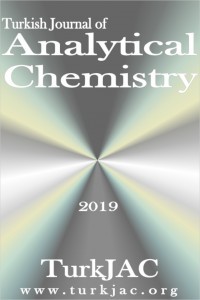Production of propolis/TiO2 (P-TiO2) nano composites for degradation of food dyes
Production of propolis/TiO2 (P-TiO2) nano composites for degradation of food dyes
Photocatalysis, Propolis TiO2, Dye,
___
- 1. Chen, X., Burda, C. 2008. “The electronic origin of the visible-light absorption properties of C-, N- and S-doped TiO2 nanomaterials” J. Am. Chem. Soc., 130, 5018–5019. DOI: 10.1021/ja711023z
- 2. Zaleska, A. 2008. “Doped-TiO2: A review” Recent Patents on Engineering 2, 157-164.
- 3. Martins, A. C., Cazetta, A. L., Pezoti, O., Souza, J. R.B., Zhang, T., Pilau, E. J., Asefa, T., Almeida V. C. 2017. “Sol-gel synthesis of new TiO2/activated carbon photocatalyst and its application for degradation of tetracycline”, Ceram. Intern. 43, 4411–4418. http://dx.doi.org/10.1016/j.ceramint.2016.12.088
- 4. Leary, R., Westwood A. 2011. “Carbonaceous nanomaterials for the enhancement of TiO2 photocatalysis”, Carbon 49, 741–772.
- 5. Dong, F., Guo, S., Wang, H., Li X., Wu, Z. 2011. “Enhancement of the visible light photocatalytic activity of C-doped TiO2 nanomaterials prepared by a green synthetic approach”, J. Phys. Chem. C 115, 13285–13292. doi.org/10.1021/jp111916q
- 6. Rahman, M. N. A., Rahim, N. A. A., Kamarudin, W. F. W., Irwan, Z., Amin, A. R. M., Muhammud, A., Muda, S. M., Akhir, N. E. F. M. 2018. “Solar photocatalytic degradation of food dye (Tartrazine) using zinc oxide catalyst” Int. J. Eng. Technol. 7, 222-226.
- 7. Zazouli, M. A., Ghanbari, F., Yousefi, M., Madihi-Bidgolie, S. 2017. “Photocatalytic degradation of food dye by Fe3O4-TiO2 nanoparticles in presence of peroxymonosulfate: The effect of UV sources” J. Environ. Chem. Eng., 5, 2459-2468.
- 8. Ranade, M.R., Navrotsky, A., Zhang, H.Z., Banfield, J.F., Elder, S.H., Zaban, A., Borse, P.H., Kulkarni, S.K., Doran, G.S., Whitfield H.J. 2002. “Energetics of nanocrystalline TiO2” PNAS 99, Suppl. 2, 6476-6481.
- 9. Zhang, H., Banfield, J.F. 2002. “Kinetics of crystallization and crystal growth of nanocrystalline anatase in nanometer-sized amorphous titania” J. Chem. Mater. 14, 4145-4154.
- 10. Koç Keşir, M., Dilber, G., Sökmen, M., Durmuş, M. 2019. “Use of new quaternized water soluble zinc phthalocyanin derivatives for effective dye sensitization of TiO2”. J. Sol-Gel Sci. Technol. https://doi.org/10.1007/s10971-019-05109-w
- 11. Sökmen, M., Koc Kesir, M., Alomar, S. Y. 2017. “Phthalocyanine-TiO2 nanocomposites for photocatalytic applications: A review” Am. J. Nanosci. 3, 63-80.
- Yayın Aralığı: Yılda 2 Sayı
- Başlangıç: 2019
- Yayıncı: Miraç OCAK
Yakup KARA, Zehra CAN, Sevgi KOLAYLI
Schiff base derivatives with morpholine and antioxidant activity
Dilek ÜNLÜER, Ersan BEKTAŞ, Yasemin ÜNVER
Abidin GÜMRÜKÇÜOĞLU, Nurhayat ÖZBEK, Tuğba AK, Elvan VANLI, Miraç OCAK, Ümmuhan OCAK
Yasemin ÇAĞLAR, Ece Tugba SAKA
Production of propolis/TiO2 (P-TiO2) nano composites for degradation of food dyes
